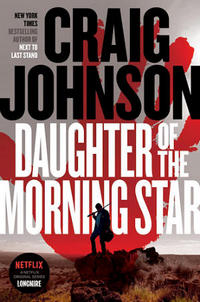 |
Daughter of the Morning Starby Craig Johnson Hardcover, 322 pg. Read: September 28-29, 2021 |

“Everybody thinks the dead of the night is the scary time, but it’s not. The time of danger for the living is the time of change, from day into night or night into day, when the world isn’t sure what it is or what it wants to be.”
What’s Daughter of the Morning Star About?
Midway through the last novel, Next to Last Stand, Walt and Henry stop by a High School Girl’s Basketball game to watch Lolo Long’s niece, Jaya “Longshot” Long, do what she does best. But they don’t stop by to enjoy the game, really, they’re there because Lolo wants help. Jaya’s been receiving death threats and there’s only so much an aunt can do (even if that aunt is a Tribal Police Chief).
This is where we pick up now—the threats are real, repeated, and don’t seem to be a prank. Adding to the danger is the fact that Jaya’s older sister disappeared the prior year under suspicious circumstances. There’s no need to think the two are linked, but Walt has to consider the possibility.
If nothing else, Lolo hopes that bringing Walt into the investigation(s) will draw attention to him—he tends to get people watching and talking about his escapades, and hopefully, his involvement will get enough people interested in what’s going on to generate some leads.
There are plenty of suspects—on the reservation and off—for both the threats and the disappearance, so Walt and Henry have their hands full.
A Recurring Question
“I’m sorry, but I don’t believe in the things you believe in, Henry.”
He nodded. “I know that, but I respect your belief in humanity, if for only one reason.”
“What’s that?”
“It makes you very resolute.”
“Is that a compliment?”
“Sometimes.”
There is a strong possible supernatural thread running through this novel. I’m not going to do justice to explaining the particular spirits that are suspected to be at work in this book, but there’s a real sense of hazard around them. And a lot of what Walt encounters during these events cannot be easily explained by something other than a spiritual force.
Of course, this isn’t the first time that this concept has been explored in the Longmire books. I don’t have hard numbers on it (I expect someone on the Internet does), but I’d guess that it’s a little less than one-half of them that feature this in a significant way.
And for all his protesting (see above), I’m not so sure that Walt doesn’t believe most of what Henry does. If your actions are an expression of your beliefs, he sure seems to. Not simply his actions over the course of this novel, there’s just about every other novel in the series—look at everything involving Virgil White Buffalo, for example (but there are several other pieces of evidence). Given both his background, what his wife believed, and his lack of knowledge about the details of Cheyenne beliefs, I can believe that Walt’s hesitant to claim that belief, but he sure does walk the walk.
Of course, there’s this observation Walt makes:
Funny how your attitude about spirituality could change when the chips were down.
A Sobering Beginning And Unfortunate Coincidence
In the midst of all the media coverage surrounding the search for Gabby Petito this summer, one of the things I frequently saw was people listing the statistics surrounding the numbers of missing Native American women every year.
The Acknowledgements in the front of this book listed similar statistics regarding missing and murdered Native American women, which are partially where Johnson drew the idea for this novel from. These numbers are repeated in the text itself, too.
This isn’t the first time that Johnson has used Walt’s case to comment on something in the news (or something that should be), but an accident of timing made this novel particularly germane.
Missing Friends
The downside to a Longmire book that takes place outside of Absaroka County is that most of the Sheriff’s department and the residents of Durant aren’t in the book. We didn’t get Sancho, Ruby, or Lucian (for example). And Vic was largely absent as well—but was well used for little time she was around.
I get the need to have Walt do things outside of Durant/Absaroka County to prevent Durant from becoming Murder Central, U.S.A. (it’s likely the most murder-filled town/county in Wyoming), but I really wish it didn’t involve leaving so many of the characters out of the books.
Here’s hoping that #18 brings them all back.
So, what did I think about Daughter of the Morning Star?
I thought some of the basketball material in the book (particularly the further in the novel we got) was a little eye-roll-inducing. It was just too much for a cynical guy like me. But somehow Johnson made it work.
There’s a lot said about hope in Daughter of the Morning Star–mostly about its absence. But, as hope tends to do, it shows up in the unlikeliest of places and in the midst of the darkest times. When this book is finished, there’s no happily ever afters promised (as usual for this series), but there’ve been moments of triumph, and maybe a dawning of hope for some.
This is really the most entertaining Longmire book in quite a while. When Johnson is on his game, he’s great. And that’s what we got here. Readers new and old will find a lot to be satisfied with here.

This post contains an affiliate link. If you purchase from it, I will get a small commission at no additional cost to you. As always, opinions are my own.
![]()


Read Irresponsibly, but please Comment Responsibly